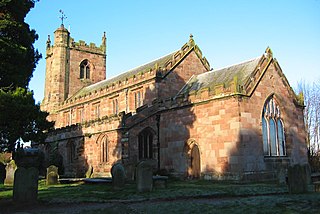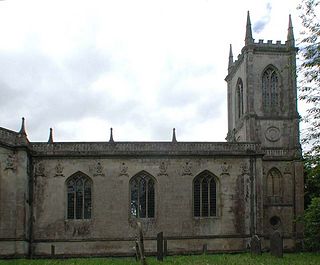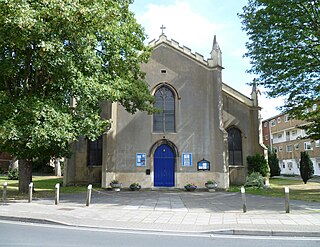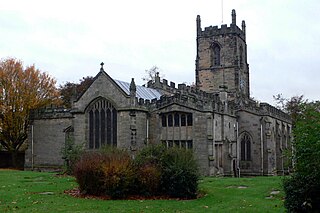
Greensted Church, in the small village of Greensted, near Chipping Ongar in Essex, England, has been claimed to be the oldest wooden church in the world, and probably the oldest wooden building in Europe still standing, albeit only in part, since few sections of its original wooden structure remain. The oak walls are often classified as remnants of a palisade church or, more loosely, as a kind of early stave church, dated either to the mid-9th or mid-11th century.

Fulbrook is a village and civil parish immediately northeast of Burford in West Oxfordshire. The 2011 Census recorded the parish's population as 437.

Bowers Gifford is a small village within the district of Basildon, in Essex, England. It is located to the east of Pitsea and to the west of South Benfleet. Bowers Gifford was formerly a civil parish, however it is now part of the civil parish of Bowers Gifford and North Benfleet.

St Margaret's Church overlooks the village green of Wrenbury, Cheshire, England. The church is recorded in the National Heritage List for England as a designated Grade II* listed building. It is an active Anglican parish church in the diocese of Chester, the archdeaconry of Macclesfield and the deanery of Nantwich. Its benefice is combined with those of St Michael's, Baddiley and St Mary's and St Michael's, Burleydam.

The Priory Church of St Mary, Abergavenny is a parish church in the centre of Abergavenny in Monmouthshire, Wales.

St Alkmund's Church is an active Anglican parish church in Whitchurch, Shropshire, England. By tradition, this church was founded in the 900s CE by the Saxon Queen Æthelflæd. Certain sources suggest that the saint to whom it is dedicated, St. Alkmund, (the son of Alhred, King of Northumbria, was first buried in Whitchurch.

St Margaret's Church is an Anglican church in the Ifield neighbourhood of Crawley, a town and borough in West Sussex, England. It is the ancient parish church of the village of Ifield; the medieval settlement was expanded to form one of the New Town of Crawley's 13 neighbourhoods, and the church's modern parish now serves several other neighbourhoods as well.

St Andrew's Church is a redundant Church of England parish church in the village of Wroxeter, Shropshire, England. It is recorded in the National Heritage List for England as a designated Grade I listed building, and is under the care of the Churches Conservation Trust. Both the village of Wroxeter and the church are in the southwest corner of the former Roman town of Viroconium.

St Mary Magdalene's Church is a redundant Anglican church near the village of Stapleford, Leicestershire, England. It is recorded in the National Heritage List for England as a designated Grade I listed building, and is under the care of the Churches Conservation Trust. It is situated in the grounds of Stapleford Park.

All Saints Church is a redundant Anglican church in the village of Little Wenham, Suffolk, England. It is recorded in the National Heritage List for England as a designated Grade I listed building, and is under the care of the Churches Conservation Trust. It stands in an isolated position close to Little Wenham Hall, about 0.6 miles (1 km) to the northwest of Capel St. Mary.

St Michael and All Angels' Church is a redundant Anglican church in the village of Thornton, Buckinghamshire, England. It is recorded in the National Heritage List for England as a designated Grade I listed building, and is under the care of the Churches Conservation Trust. The church stands to the north of the village, in the grounds of Thornton Hall, to the east of the River Ouse, some 4 miles (6 km) northeast of Buckingham.

St Mary de Lode Church is a Church of England church immediately outside the grounds of Gloucester Cathedral. It is believed by some to be on the site of the first Christian church in Britain. The church is in the Diocese of Gloucester and Grade I listed by English Heritage. It has also been known as St. Mary Before the Gate of St. Peter, St. Mary Broad Gate and St. Mary De Port.

St Helen's Church is the Anglican parish church of Ashby-de-la-Zouch, in the deanery of North West Leicestershire and the Diocese of Leicester. There was a church in the town in the 11th century, but the core of the present building mainly dates from work started in 1474, when the church was rebuilt by William Hastings at the same time that he converted his neighbouring manor house into a castle. The church was refurbished in about 1670 to create more space, but the large and increasing size of the congregation led to further work in 1829, and a major rebuild in 1878–80, including the widening of the nave by the addition of two outer aisles.

All Saints' Church, also known as Lydd Church or The Cathedral on the Marsh, is a church in Lydd, Kent, South East England. It belongs to the Diocese of Canterbury. All Saints is the longest parish church in Kent at 199 feet (61 m), and also has one of the tallest towers in the county at 132 feet (40 m). The church is thought to incorporate a small Romano-British basilica possibly built in the 5th century, though most of the current fabric is medieval. It was associated with local fraternities or guilds in the 15th century and could seat 1,000 people at a time. Severely damaged by World War II bombing, the church was subsequently restored and is now a Grade I listed building.

The Church of St John the Evangelist is a Grade I listed Church of England parish church dedicated to John the Evangelist, in Corby Glen, Lincolnshire, England. The church is 9 miles (14 km) south-east of Grantham, and in the South Kesteven Lincolnshire Vales. It is noted in particular for its 14th- and 15th-century medieval wall paintings.

Church of St Simon and St Jude Church is a late 12th century parish church in Castlethorpe, City of Milton Keynes, Buckinghamshire, England. It was formerly a chapelry of Hanslope. Of note is the Norman font with figures at the corners. It was designated a Grade I listed building in 1966.

The Church of Saint Mary the Virgin is the Church of England parish church of Bampton, West Oxfordshire. It is in the Archdeaconry of Dorchester in the Diocese of Oxford.

St Andrew's Church is the Anglican parish church for the town of Biggleswade in Bedfordshire, England. The church is Grade II* listed and comes under the Diocese of St Albans. The church is noted for its monumental brass of John Rudying of 1481 featuring the Figure of Death.

The Church of All Saints in Radwell in Hertfordshire is an Anglican parish church which falls within the Diocese of St Albans. It is a Grade II* listed building, having gained that status in 1968.

The Church of St Nicholas is a Church of England parish church in the village of Hinxworth in Hertfordshire and is a Grade II* listed building dating mostly to the 14th century. The church comes under the Diocese of St Albans.























